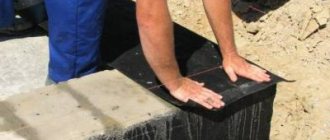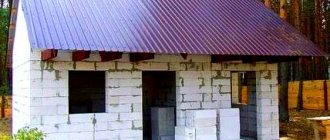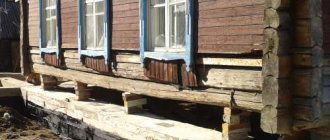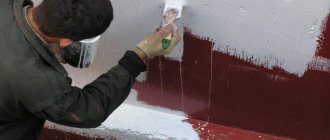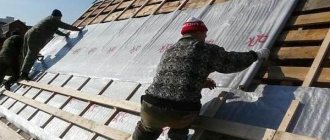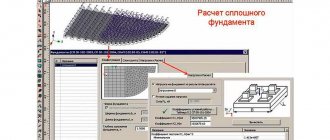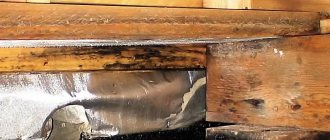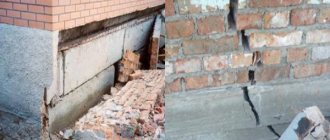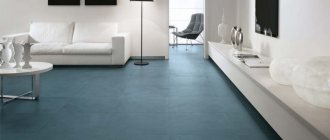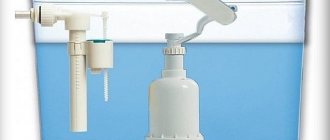Simple waterproofing is easy to do with your own hands, but it is necessary to provide for its type at the design stage. Here the main criteria are: what type of waterproofing is needed in the specific hydrogeological conditions of the load-bearing soil layer, economic justification, the possibility of using the technology, and the availability of materials. This is important to know for the correct formation of foundation protection.
Types and types of waterproofing
Foundation waterproofing is based on three main types:
- horizontal,
- vertical,
- drainage.
Gone are the days when the only type of waterproofing was to apply a layer of bitumen to the side walls of the foundation. In Russia, with the development of technology parks, clusters with modern laboratories and accessible equipment are being formed where projects are being developed in the direction of obtaining innovative technologies and materials for protecting surfaces from the effects of water.
Horizontal and vertical waterproofing
Here are some modern types of waterproofing used to protect and strengthen foundations:
- coating,
- pasting,
- welded,
- penetrating,
- injection with microcements,
- polymer cement,
- liquid,
- elastic,
- membrane,
- cut-off,
- seamless rubber,
- application of polyurea,
- shotcrete,
- drainage,
- water reduction
The main thing here is to choose the right type of waterproofing necessary to protect the foundation. The work is carried out in accordance with the provisions of SP 71.13330.2012.
It is important to understand that not all types of protection can be performed independently. There are those when special equipment and materials are required. This significantly affects material costs, time of work on E&R and in reality. To the question of whether it is necessary to do waterproofing, there is only one answer - it is necessary, even if at the given period the soils are not wet and the groundwater level is deep.
Waterproofing work is carried out only on a cleaned, leveled, dry surface (SP 45.13330 clause 15.3). Permissible humidity is standardized according to SP 71.13330.2012.
Before use, carefully read the manufacturer’s recommendations for the use of the material: permissible temperature of the material during application or gluing, maturation period for multi-component material, time during which it is necessary to apply the material to the concrete surface. Following the manufacturer's instructions will ensure long-term surface protection.
The applied waterproofing must be protected by a protective film, synthetic coating, and polymers (SP 45.13330 clause 15.7). Carefully monitor the integrity of the insulation and carefully fill the sinuses. In seismic areas, insulate communication pipeline entries using elastic materials (SP 45.13330 clause 15.21).
Materials for the blind area
This list includes:
- Asphalt concrete. It is fixed close to the foundation;
- Concrete. To do this, structures are made from the foundation, into which a liquid concrete solution is poured. The width of this blind area should be from 100 to 150 cm;
- Paving slabs. It is fixed close to the foundation structure;
- Clay solution. This type of waterproofing layer is considered budget and affordable. However, it is not suitable for long-term use. High humidity and climatic disasters lead to the destruction of the protective layer;
- Special types of waterproof membranes. They consist of non-woven material and polymer particles that do not allow moisture particles to pass through. Over time, such waterproofing is deformed under the influence of solar insolation and climatic conditions.
Coating waterproofing
Coating vertical insulation is one of the oldest, but still quite popular today methods of protecting reinforced concrete structures from moisture. Modern innovative materials for the formation of protective coatings allow:
- apply insulation to any previously prepared surface, regardless of configuration;
- carry out the process of applying the material with a roller, brush, or spatula without the use of special mechanisms;
- form a monolithic protective layer on the surface;
- close pores, microscopic shrinkage cracks, securely attach the protective layer to the surface being treated.
Materials for coating insulation are supplied in ready-to-use form or as a multi-component kit. Please read the instructions carefully before use. Some popular materials for vertical coating insulation and their characteristics are shown in the table below.
| Material | Type of delivery | Description | Price |
| Insulating mastic 10 liters | Waterproofing mastic based on petroleum bitumen with technological and mineral additives. Average consumption - 1 kg/m^2. Ready to use. | 389 | |
| Bitumen-rubber mastic 10 liters | Mastic based on modified bitumen, plasticizer with antiseptic additives, corrosion inhibitor. Ready to use. Consumption 1 kg/m^2. Read the instructions for safe use carefully. | 284 | |
| Waterproofing mastic Bitumast 5 liters | Coating mastic used for mildly and moderately aggressive soils. Consumption 0.5 kg/m^2. Does not contain toxic solvents, flammable. | 390 | |
| Hiperdesmo-Classic mastic 1 kg | Polyurethane one-component mastic. Designed for repairing bitumen insulation. Average consumption - 1.3 kg/m^2. | 699 |
How to protect masonry from getting wet through the seams?
Oksana12345FORUMHOUSE participant
Please advise how to solve the problem. The facade of the house is made of 8 cm finishing bricks. The wind rose in our area is such that during rains the wind always blows into one wall almost at a right angle to it. The brick becomes very damp, even the wallpaper becomes damp from the inside. Now we will treat it with a hydrophobe, but this is only part of the problem. There are micro cracks in the masonry seams into which the wind forces water under pressure. How to treat these seams? And will the sealant adhere after the hydrophobe?
Answer from a GLIMS expert.
— Simply treating the wall with a water-repellent primer will not be enough in this case. Since water-repellent soils can seal pores in the base up to 0.2 mm. This problem must be approached comprehensively:
- Seams on brickwork - it is necessary to widen (deepen) by 5-10 mm, since there are already micro-cracks in the seams, plus we will make a reserve in depth for laying new material.
- Treat the prepared surface with waterproof deep penetration primer once and allow to dry for at least 4 hours.
- Seams, filling: if the seams are gray, we recommend using reinforcing hydrophobic putty for filling; if the seams are white, we recommend using leveling high-strength hydrophobic putty for filling, this way we will remove saturation of the wall through the seams of the brickwork. Allow the applied putties to dry for at least 3 days.
- Applying a water repellent over the entire surface of the wall - for this it is best to use a waterproof, deep penetration water repellent based on silicone. We carry out the application in two layers, wet on wet, that is, after applying the first layer, we do not allow it to dry, but immediately begin applying the second layer, from the same place where we began to apply the first layer.
This system of using materials will allow you to protect the wall from getting wet and saturating it with water. In this case, the water repellent will not have to be applied every year; it will be enough to treat the walls once every 3-5 years, depending on the intensity of the rains during the season.
The difference between our silicone-based deep penetration water repellent and analogues:
- Water-based - does not contain solvents, safe for health.
- Does not create a film - vapor permeable, allows walls to breathe.
- Does not change the color of the base and does not create a glossy film - does not disrupt the existing design.
- Easy to apply - can be applied by brush, roller or spray.
- Protects decorative coatings from UV rays.
Polymer cement foundation protection
The material, according to the application method, refers to coating insulation. Supplied in bags as a dry mixture or an aqueous solution.
The main components are cement, sand, polymer, additives that accelerate the dehydration process and improve the properties of the material. It is necessary to strictly follow the recipe for preparing the mixture.
When applied to the surface, the polymer-cement mixture penetrates the pores, cracks, and structure of concrete, enhances its hydrophobic characteristics, and creates an impenetrable barrier against groundwater. The mixture is applied with a brush, roller, or trowel in one or several passes.
After drying, a membrane is formed, firmly connected to the surface of the concrete, impermeable to water. The disadvantages of the method include:
- Formation of microcracks during the rapid formation of a protective layer or deformation of the base.
- Strict adherence to the proportions and quality of water when preparing the polymer-cement mixture.
Features of implementation in an already built private house
Often, in a purchased or already rebuilt house, where mistakes were made during the construction stages, there is a need for waterproofing measures. An alarm signal is wet walls, fungus in the basement, and dampness. How to waterproof if the house has already been built?
To do this you need to immediately:
- Inspect the basement, ground floor inside the house. Conduct a visual inspection of the outside of the house for cracks in slabs and bricks.
- Determine the scope of work on the outside and inside of the foundation.
- Inside the basement of the finished house:
“breathing” joints are freed from the old mortar, cemented or filled with sealant; - a disinfectant, antifungal composition is applied to walls cleared of fungus;
- the floor is cleaned and treated with a polymer with waterproofing properties
- a reinforced mesh is laid on the set floor;
- a concrete screed 5 cm high is made;
- After the screed has dried, all vertical surfaces are treated with a primer and sealing compound.
- Outside the building you need:
- provide access to the foundation walls, dig in a separate problem area;
- if the foundation was not properly waterproofed during construction, soil will have to be removed along the entire contour of the house;
- eliminate defects, cover gaps and cracks with cement mortar with a hydro- and frost-resistant composition; in cold weather, it can be used to prepare an “anti-freeze” mixture;
- apply primer and bitumen mastic to the treated surfaces, secure the roll material, following the technology.
- Equip a drainage system around the perimeter of the building.
- Make a blind area.
Elastic waterproofing
Such rubber insulation is called elastic.
Elastic insulation refers to the application of a coating of liquid rubber - bitumen-latex emulsion by spraying. The material is supplied one-component or two-component.
The process of applying the emulsion requires the use of special technology and equipment. When using a two-component material, you must have a sprayer with two nozzles. According to the technology, mixing of components occurs at the moment the material hits the surface to be treated.
Requirements when applying the emulsion:
- Clean the surface from dust, oil stains, and prime.
- The emulsion is sprayed onto a dry surface at a temperature > +5 degrees.
- The formation of the membrane occurs within 2 hours; moisture ingress during this period is not allowed.
- Spraying on vertical surfaces is done from bottom to top without joints.
- When carrying out work, comply with safety requirements, wear protective clothing and glasses.
Foundation protection with polyurea
Polyurea is a multicomponent organic polymer. Components: isocyanate, polyester amine resin.
To apply polyurea, you will need special equipment that provides heating before spraying the components to a temperature of >+80 degrees, separate supply to the mixing chamber of the gun and to the treatment site under a pressure of >1.7 atm.
Polyurea is applied for horizontal and vertical waterproofing.
After connecting the components and contacting the surface to be treated, the mixture hardens within 10 seconds. A durable layer is formed, similar to hard rubber or plastic.
Characteristics of the resulting polyurea layer:
- thickness: 0.5—2.5 mm;
- Full readiness for use 1 minute after application;
- no seams;
- operating mode from -60 to +250 degrees;
- strength up to 80 Shore D;
- corrosion and abrasion resistant coating;
- service life >30 years.
Why waterproof concrete?
Concrete, which is prepared using typical technology, is a structure filled with microcracks, pores, and capillaries. It is formed during the maturation of artificial stone and is caused by a number of factors - evaporation of water, poor compaction during pouring, development of internal stresses, etc.
Waterproofing helps prevent through filtration of water through the concrete body - it is enough to add a special additive to the mortar mixture or treat the finished structure with a waterproofing material. In both cases, pores, cracks, and capillaries are filled with chemically resistant, insoluble crystals. .
Modern mixtures make it possible to increase the water resistance of structures by 6 levels or more, for example, from W2 to W14
Penetrating waterproofing
The coating type includes an innovative technology for protecting concrete from capillary filtration of water - penetrating insulation (penetrating). Unlike mastics, solutions of penetrating insulation work in the concrete body itself, contacting and spreading through capillary channels, microcracks up to 0.3 mm towards water under the influence of osmotic pressure.
Upon contact with water, chemically and biologically resistant crystals are formed that block capillary channels and cracks. In addition to maintaining the water resistance of the concrete body, resistance to acids, alkaline solutions, frost resistance up to P 300 increases, and a mechanically and chemically strong layer is formed on the surface.
The dry mixture includes:
- Portland cement mixture
- specially treated sand,
- complex of chemical additives.
The technology of application is similar to the coating method of application:
- The surface is being prepared. It is cleaned of dust, dirt, and grease to open the capillary channel systems as much as possible. The surface is moistened until completely saturated, primed with a solution of 1 part water and 1 part dry mixture.
- The working solution for application to the surface must be prepared according to the instructions, taking into account the volume that is consumed during 30-45 minutes of continuous work.
- The finished solution is applied with a brush, spatula or shotcrete method for large volumes of work outside and inside the foundation.
| Material | Type of delivery | Description | Price |
| Aquatron 6 5 kg №5 | Used as an additive to concrete mix - 3% by weight of concrete or applied as a solution on both sides of the foundation of buildings with a basement | 1200 | |
| Gidrotex-B - hydroseal 6kg №6 | It is used for sealing and eliminating pressure leaks with constant active infiltration of groundwater in basements. | 1016 | |
| Biytron F-6 №7 | Ensures the tightness of the foundation at a pressure of up to 2 MPa, the strength of the resulting coating >300 MPa, operation from -60 to +200 degrees. | 400 per 1 kg |
Waterproofing composition Penekrit
Penecrit
Waterproofing measures to eliminate moisture filtration through joints, utility lines, and junctions of concrete structures are carried out using Penecrit mortar and Penebar gasket. Waterproofing Penekrit, along with its use in new construction, is also used to protect surfaces in reconstructed buildings.
Hydraulic gasket Penebar
The Penebar hydraulic gasket is an insulating harness made of special composite materials. Serves to seal construction joints and places where utility lines enter the building.
When it comes into contact with water, it swells and completely fills the cavity of the seam or hole. It is used only together with the material Penecrit and Penetron when installing or repairing concrete structures, or with the additive Penetron Admix for monolithic construction.
Application of Penebar gasket
Preparation of Penecrit composition
Mix Penecrit with water in a ratio of 1:4 until a homogeneous mass resembling plasticine is obtained. The amount of the finished solution should not exceed 5–7 kg per use.
If the size of the joint between structures is more than 30 mm, then it is allowed to use crushed stone of small fractions no more than 50% of the total volume of the finished mixture.
Application of Penecrit mixture
Clean the junctions along the length of the grooves (grooves) around the entrance of utility lines with a metal brush. Using a hammer drill, cut the crack cavities to a width of 25 mm and a depth of 40–50 mm.
Moisten the prepared fine with water and prime it with Penetron. Using a trowel or spatula, fill the treated furrows hermetically with the prepared Penecrit mixture.
Filling furrows with Penecrit mixture
The thickness of the filled layer of Penecrit composition in one pass should not exceed 30 mm. If the depth of the furrows is more than the standard, then the solution must be applied in several stages.
Moisten the fine and adjacent concrete surfaces with water and treat with Penetron waterproofing twice.
Surface treatment
The consumption of the penetrating composition Penecrit, with a fine size of 25 mm, will be 1.5 kg/l.m. As the cross-section of the furrows increases, the amount of solution used will change proportionally.
Pasted waterproofing
The use of adhesive insulation is a simple and quick method of protecting the foundation of a shallow house, buried with a basement or without a basement.
Material classification:
- based on bitumen with a built-up or self-adhesive backing;
- polymer;
- bitumen-polymer;
- PVC membranes;
- cutting off.
Laying built-up waterproofing
The technology for installing roll materials is simple, accessible for doing the work on your own:
- The surface is prepared, leveled, and dried.
- A layer of pasting mastic and hot bitumen with a temperature of >200 degrees is applied. Layer thickness >5 mm.
- The material is glued and rolled tightly onto the surface with a roller. Pasted waterproofing can be multi-layered, but only with mastic.
- Overlap horizontally >150 mm, at vertical joints >100 mm.
- The joints are additionally coated with polymer glue.
- Coating insulation is applied to the top layer.
Innovative PVC membrane protection is applied in the same way. The application of polymer (membrane) has no restrictions in weather conditions (up to -15 degrees) during installation. The seams are welded with a heat gun or covered with tape.
PVC membranes are of film or profiled type for uniform distribution of soil pressure along the foundation wall and drainage of groundwater. The cost of a PVC membrane varies from $30 to $120 per 50 m.p.
Materials intended for fused insulation have an adhesive bitumen or polyethylene layer. During installation, the roll is laid with the adhesive side to the surface of the tape, heated by a burner over the area, pressed and rolled out with a roller. The joints are treated with hot bitumen or polymer glue. It is recommended to apply 2-3 layers of protection using roll materials.
Shotcrete and drainage
Shotcrete is the most effective method of vertical waterproofing of foundation walls and joints. The principle of shotcrete is applying under pressure to the surface to be treated a mixture of well cement with hard coarse-grained sand without impurities or artificial sand.
Shotcrete technology requires the use of specialized equipment, so this work cannot be done correctly on your own. You will have to place an order with a third party.
Shotcrete eliminates all questions regarding waterproofing the foundation. The service life of the object is unlimited.
Linear drainage is used to drain moisture-saturated soils by laying perforated pipes and draining water into special sumps with subsequent pumping.
Linear drainage is installed below the support pad of the foundation base. First, geotextile (dornite) is placed under the base of the pillow in 2 layers with the side ends bent 70-80 centimeters, horizontal waterproofing is done on top of the pillow. Then a perforated pipe is laid down with a slope towards the sump, covered with a sand-gravel mixture as a filter material, and the ends of the geotextile are bent.
conclusions
How to protect concrete from water? There are no universal methods. Each type of structure, each unit, seam may require an individual technological solution. However, for finished structures in use, located outdoors and indoors under high hydrostatic loads, it is better to use cement penetrating waterproofing, including at seams, abutments, and joints .
Special additives will help out during the construction of objects. This is a completely convenient and modern solution that can modernize concrete even at the preparation stage. This method of waterproofing, such as injection, is in demand where general repairs of structures are carried out. This method is economical and does not require significant labor costs. In turn, a hydraulic seal will help out in eliminating local problems that require immediate intervention.
